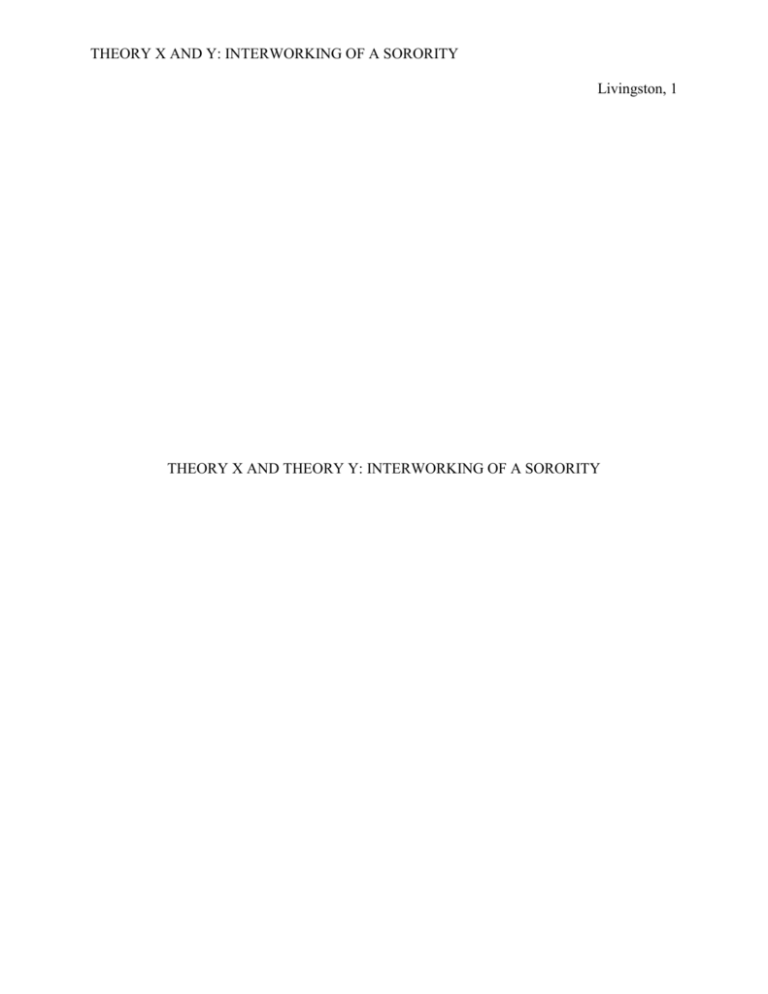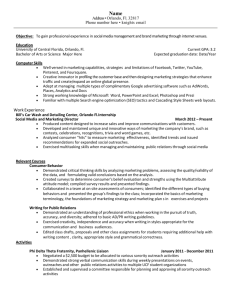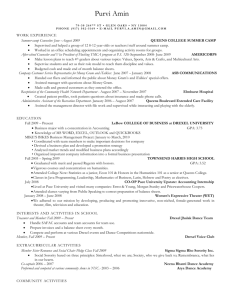File - Britny Livingston E
advertisement

THEORY X AND Y: INTERWORKING OF A SORORITY Livingston, 1 THEORY X AND THEORY Y: INTERWORKING OF A SORORITY THEORY X AND Y: INTERWORKING OF A SORORITY Livingston, 2 Britny Livingston COM 426 Roast Pig Paper 9 February 2016 Theory X and Y: Interworking of a Sorority Theory X and Theory Y are two contrasting theories of human motivation in a workforce. “Theory X and Y were created and developed by Douglas McGregor at the MIT Sloan School of Management in the 1960s.” They have been utilized in human resource management, organizational behavior, organizational communication and organizational development. These two theories are the perceptions that managers have on their employees, based on their attitudes towards working. Theory Y managers are more likely than Theory X managers to develop an atmosphere of trust with employees that is a requirement for human resource development. In this paper I will speak briefly on what the logistics of Theory X and Theory Y are. After the theories are introduced I will move on to a more personal story and how these theories do affect me. I will then flip these theories out of their normal routine into something completely different, the interworking of a sorority (Wikipedia, Theory X and Y). Theory X Theory X is a theory in which the management of an organization assumes employees are lazy and will avoid any work if they can and that they dislike work all together. According to this theory management believes that workers need to be closely supervised at all times because they are not capable of self-control. Theory X explains that employees will show little or no THEORY X AND Y: INTERWORKING OF A SORORITY Livingston, 3 ambition when there is not an incentive program, they will avoid responsibility whenever possible. Managers in this theory believe that if there are goals that need to be met, they need to rely heavily on threat to gain their employees’ respect and obedience so they can achieve these organizational goals. Not gaining the respect and obedience that they want, managers might create an atmosphere of mistrust and discipline and highly restrictive supervision. The Theory X manager tends to think that everything must ultimately end with blaming someone (the employee). They think that all employees are only there for themselves, and that the only purpose and interest for their employment is the money. The manager will blame an employee for whatever has happened first, instead of blaming what could actually be the problem, such as lack of training or a system malfunction (Wikipedia, Theory X and Y). Theory Y “Theory Y is a theory in which management assumes employees are ambitious, motivated and practice self-control. Employees will enjoy their work duties mentally and physically, and they possess the ability for creative problem solving, but their talents are underused.” Theory Y managers believe that employees are there to work, they will seek out and accept responsibilities, they will be self dedicated to finish projects that they are given. The employees in Theory Y believe that there is a satisfaction in doing a good job, and that it is strong motivation when they receive positive reinforcement. Many think that Theory Y is a set of positive beliefs about employees. Theory Y managers are more likely than Theory X managers to develop a positive atmosphere. The trust with employees that is a requirement for human resource development and that it definitely something that Theory X is lacking. Human resource THEORY X AND Y: INTERWORKING OF A SORORITY Livingston, 4 development is a crucial aspect of any organization, big or small. The human resource development within an organization would include managers communicating with those who are “under” them, creating a comfortable work environment in which the members or employees of the organizations can show their potential (Wikipedia, Theory X and Y). Personal Experience: The “Flip” As many people around campus and in the communication classes know, I am in the sorority Sigma Sigma Sigma. We are the “new” social sorority on campus, so we have to work hard to become a great chapter like the rest of the Greek Organizations on campus. Being in a sorority is a huge obligation, everyone should have a chair position and we have standards of membership that we must uphold. I would compare the responsibility of being in a sorority to the responsibility of having a regular job. It is partly your job to keep the chapter afloat, if one person fails it hurts the chapter and could result in the whole chapter failing. However, it could be someone else to blame. Later in this paper you will notice that I have flipped the X and Y Theory to “match” the interworking of a sorority. I will start with Theory Y, to show how things should be done and handled and then I will move on to Theory X, to show how things are not supposed to be handled but ARE currently being handled. In other words I will show how Sigma Sigma Sigma-Theta Beta Chapter on the University of Michigan-Flint is currently managing based on Theory X and Y. When I first joined Sigma Sigma Sigma it was more like Theory Y and now that I have been in it for almost four years it has turned kind of into a Theory X situation. Theory YIn the beginning everyone was positive, they all believed that the new members and all of the old THEORY X AND Y: INTERWORKING OF A SORORITY Livingston, 5 members were motivated and had self-control. And “they” were right, we all wanted to be in the sorority, we wanted sisterhood and scholarship. We were determined to be the best we could be and the way that our E-Board (Executive Board) looked at us was the way managers look at their employees in Theory Y. Knowing that our E-Board members held us to such high standards and believed that we were doing a great job and no matter what we would do a great job, made us want to do more good for the sorority. Everyone likes an environment where you are able to show your potential, and that’s what we were able to do because we were rewarded (not with gifts but with our sisters being proud of us) for what we did. When I first started in the sorority I was told that it was going to be one of the best experiences of my life. I knew that it would cost me money each month but I was willing to pay that to have everything that I have now. Such as: volunteer experience, leadership experience and social experience, not to mention the great memories that I will have forever. Not a lot of things were mandatory and God and Family always came first. When I knew that this was the case it made me want to spend time with my sisters and come to things. This would be compared to Theory Y because our E-Board (managers) would give us positive reinforcement and it made us members (employees) want to do more and have a determination to do more for them. Both of us together created a positive environment for each other because we were both happy with what was going on at the time. This was the type of “management” that I like and I believe that the idea of Theory Y should be what is portrayed around all businesses. On the complete other side of the spectrum, there is Theory X. This is how the sorority seems to be ran now, and it still isn’t really that bad I just think that I don’t like the change as THEORY X AND Y: INTERWORKING OF A SORORITY Livingston, 6 much as others do so I think that it has changed drastically when really it has probably only changed a little bit. The management of the sorority right now is all over the place. The E-Board members do not really believe in us active members and we are usually criticized or judged on what we do do. Instead of saying that we did a good job it’s always “we didn’t make that much” or other things. Since it is a negative environment and we are looked down upon like we are lazy and do not want to do anything for the chapter and just for ourselves it makes everyone whose used to work really hard not want to work hard anymore because they are not appreciated. This makes us not want to participate in anything, therefore, the ones “in charge” decided to make almost everything mandatory. If we miss a specific event we could be sent to honor council. Honor council is the disciplinary board in our sorority. Moral of the sorority being compared to Theory X is the E-Board members (management) looks down upon us and therefore we do not want to do anything to help them. We are not lazy but we seem lazy based on the type of environment they provide us with. Conclusion Theory X and Theory Y are two contrasting theories of human motivation in a workforce. “Theory X and Y were created and developed by Douglas McGregor at the MIT Sloan School of Management in the 1960s.” They have been utilized in human resource management, organizational behavior, organizational communication and organizational development. These two theories are the perceptions that managers have on their employees, based on their attitudes towards working. Theory Y managers are more likely than Theory X managers to develop an atmosphere of trust with employees that is a requirement for human THEORY X AND Y: INTERWORKING OF A SORORITY Livingston, 7 resource development (Wikipedia, Theory X and Y). Theory X and Theory Y are really interesting to me because you can use them towards anything. It was really easy for me to pick a topic because it was something I could relate to. These theories are so different and I think that is why it is so easy to apply these theories to so many things. THEORY X AND Y: INTERWORKING OF A SORORITY Livingston, 8 Works Cited "Are You a Theory X or a Theory Y Leader?" In-plant Graphics. N.p., n.d. Web. 20 Feb. 2013. "Related Materials." Douglas Mcgregor's Motivational Theory X Theory Y. N.p., n.d. Web. 21 Feb. 2013. Sahin, Faruk. Journal of Management and Organization 18. 2 (Feb 2012): 159-174. “Theory X and Theory Y.” Collins Dictionary of Business. London: Collins, 2006. Credo Reference. Web. 20 February 2013 “Theory X and Theory Y.” The New Penguin Business Dictionary. London: Penguin, 2003. Credo Reference. Web. "Theory X and Theory Y." Theory X and Theory Y. N.p., n.d. Web. 21 Feb. 2013. "Theory X and Theory Y." Wikipedia. Wikimedia Foundation, 21 Feb. 2013. Web. 21 Feb. 2013. "Worker Participation/Theory X and Theory Y/Zero-Sum Management." FT.com (2002): 1. ABI/INFORM Complete; ProQuest Newsstand; ProQuest Research Library. Web. 20 Feb. 2013. (I used all of these websites and journals in the first part of my paper, when I was describing Theory X and Theory Y (they pretty much all said the same thing), I also would like to admit to using www.easybib.com to cite the websites I used. Therefore, I do not know for sure if they are sited completely correct. I tried to fix the ones that I knew didn’t look right, into something that I thought was right.)






